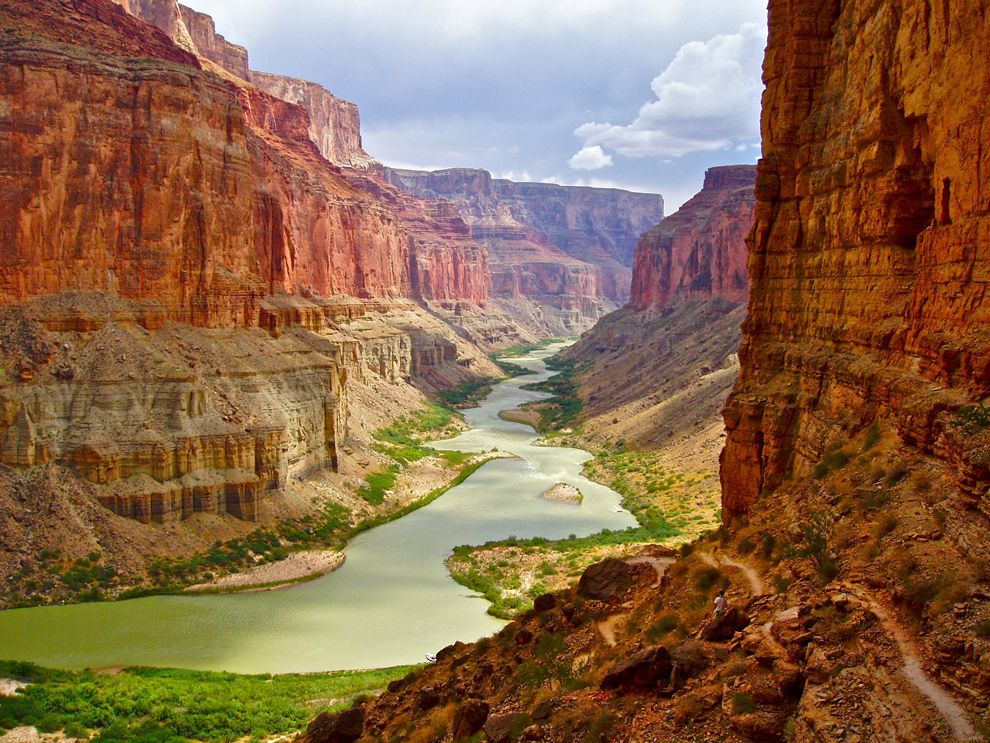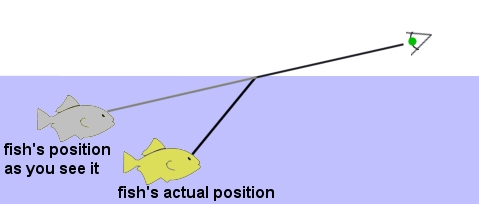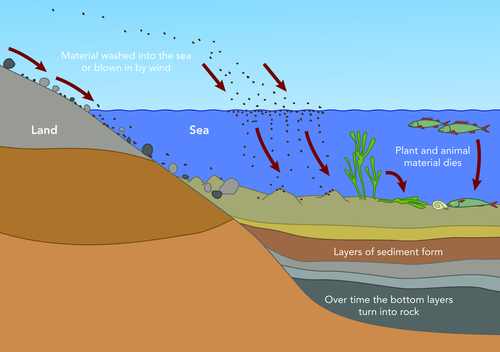
Which of these describes how this canyon was most likely formed?
F) Floods eroded the sandstone away from the canyon walls.
G) Glaciers eroded the canyon rock as they melted and moved.
H) Ice wedged into cracks in the rock and weathered the canyon walls.
J) Wind blew large rocks that smashed against the canyon walls.
F - Floods eroded the sandstone away from the canyon walls.
**STAAR Question
What type of rock is formed by weathering and layering?
A)mineral
B)igneous
C)sedimentary
D) conglomerate
C - Sedimentary
While washing dishes on a sunny morning, Ashley could see an image of herself in the window. Why could Ashley see her image in the glass?
A) Some of the light was reflected off the window.
B) The light passed through the window.
C) The light split into colors when it passed through the window.
D) The light was absorbed by the window.
A - Some of the light was reflected off the window.
Fossil fuels formed over long periods of time after particles in water settled to the sea floor and formed marine mud. What kinds of particles needed to be present in the marine mud in order for fossil fuels to form?
F) Mostly sand and a few small bits of wood
G) Mostly decaying organisms
H) Mostly lava and a few sedimentary rocks
J) Mostly metal minerals
G - Mostly decaying organisms
**STAAR Question
What is light energy?
The only energy we can see with our eyes.
This landform is made by the depositing of sediments
Delta
Erosion is one of the processes involved in the formation of sedimentary rock. Which of these best describes the process of erosion?
A) Rocks are broken into smaller pieces that remain in the same location.
B) Pressure compacts layers of sediment and turns them into rock.
C) Pieces of rock or soil are carried from one place to another.
D) Sediment grains fall to the bottom of a lake to for sedimentary layer.
C - Pieces of rock or soil are carried from one place to another.
**STAAR Question

This diagram below shows a fish being viewed from above the water.The fish appears to be closer to the surface than it really is. What causes this difference?
A) Light is reflected.
B) Light is refracted.
C) Light is focused.
D) Light is blocked.
B - Light is being refracted
**STAAR Question
All of these are related to the formation of oil or natural gas EXCEPT ...
A) Decomposed animals
B) Decayed plants
C) Sedimentary rocks
D) Active volcanoes
D - Active volcanoes
A physical structure on Earth that occurs naturally is a -
landform
A wide U-shaped valley is shown in the photograph below.

This valley was most likely formed by —
F) flash flooding
G) a glacier
H) a hurricane
J) melting snow
G - a glacier
** STAAR Question
Some students make a model to show one of the first steps in the formation of sedimentary rock. The students pour 2 centimeters of light-colored sand into a clear plastic box. Then they add 1 centimeter of gravel. Finally they pour 2 centimeters of dark-colored sand on top of the gravel. Which characteristic of sedimentary rock does this model best show?
F) Sedimentary rock is made of layers.
G) Sedimentary rock is cemented bits of rock.
H) Sedimentary rock is often limestone.
J) Sedimentary rock is common in Texas.
F - Sedimentary rock is made of layers
**STAAR Question
The Moon does not produce light. What makes it possible to see the Moon from Earth?
A) The craters from the Moon absorb light.
B) The Moon has a thin layer of ice surrounding it.
C) Light from the Sun is reflected by the Moon.
D) Water vapor around the Moon collects light rays.
C - Light from the Sun is reflected by the Moon.

This photograph shows plants growing on the surface of a pond. How do plants like these form fossil fuels?
A) The dead plants get buried for millions of years and form fossils that attract carbon.
B)The dead plants sink to the bottom of the pond and are consumed by decomposers.
C) The dead plants produce carbon that is consumed by fish, which form fossils.
D) The dead plants sink to the bottom of the pond and get buried by sediments for millions of years.
D - The dead plants sink to the bottom of the pond and get buried by sediments for millions of years.
What does Decomposition mean?
the process by which dead plants and animals decay or rot
A student is hiking in a rocky area on a mountain notices that wide, deep cracks have formed in some of the large rocks. Some of the cracks are so large that the rocks have broken apart. Which process most likely caused these rocks to crack and break?
A) Erosion by wind
B) Water freezing and thawing
C) Erosion by fast-moving water
D) Sediments being deposited
G) Water freezing and thawing

The model shows layers of sediment on the floor of an ocean. Which of the following best explains how these layers can become rock over many year?
A) Sand in the sediment melts and turns into rock.
B) The weight of the water compacts the sediment into the rock.
C) Changing water temperatures turn sand in the sediment into rock,
D) Pollution caused by humans turns the sediment into rock.
G - The weight of the water compacts the sediment into rock.
**STAAR Question
Marlis shined two flashlights into a tank of water. She noticed that the light did two different things. She made notes about the paths of the light as shown in the diagram. She concluded that —
A) the light of both flashlights was reflected
B) the light from Flashlight A was reflected, and the light from Flashlight B was refracted
C) the light of both flashlights was refracted
D) the light from Flashlight A was refracted, and the light from Flashlight B was reflected
D - the light from Flashlight A was refracted, and the light from Flashlight B was reflected
The figure below shows the rock layers in a hill. Which rock layer will have the oldest fossils?
A) 1
B) 2
C) 3
D) 4
A - 1
Explain the difference between Reflect and Refract
Reflect is when light rays bounce off of a shiny surface. Refract is when light rays pass through a medium and bend.
The Rio Grande Valley is located at the southern tip of Texas at the end of a long river known as the Rio Grande. How did the delta at the end of the Rio Grande form?
A) Sand and mud from the Gulf of Mexico were washed ashore by tsunamis.
B) The river cut through the solid bedrock of the valley.
C) The river deposited large amounts of sediments from land erosion.
D) Hurricanes pushed soil and debris from the Gulf of Mexico onto the land.
Take turns naming the five steps in forming sedimentary rock and explain each one
Weathering - breaks rock down into sediments
Erosion - carries sediments away
Deposition - drop/deposits sediments in a new location
Compaction - presses/squeezes sediments together with a lot of pressure
Cementation - glues/ sticks the sediments together to create sedimentary rock.
Your big brother Todd just polished his new snowboard with Turbo Tech wax. Which picture shows how light will behave when it strikes Todd’s shiny snowboard?
AB
C
D
A
Name 3 facts about fossil fuels
1. They take millions of years to form.
2. They are nonrenewable.
3. They are formed from decayed plants and organisms.
4. Fossil Fuels are coal, oil, and natural gas.
5. Fossil fuels start in a swampy area.
Explain the difference between Convex and Concave lenses
Convex lenses bend light ray inward, they make objects appear larger and closer.
Concave lenses bend light rays outward, they make objects appear smaller and further away.